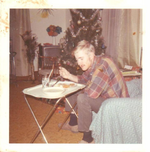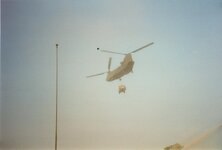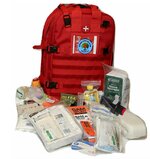I came to the frightening realization that, while I have been through the Army's Combat Lifesaver course, several CPR and trauma courses that I feel I can competently stabilize my riding friends until we can get them to help, I am totally screwed if I am the one injured after looking over my friends kits and their knowledge of use. Sure there are plenty of CPR classes out there to take. I have heard Dan Adams came to my local dealer to go through some Avy safety training. But I do not see much out there for training outside of some of the private tactical schools when it comes with dealing with trauma. I have to say the 4 days I spent going through the military combat life saver courses was one of the best detailed courses I ever took years ago. I've been through several since and have to say I have been through some really bad ones that I could have just as well stayed home and watched the power point.
Most of the kits online are the equivalent of my mothers bathroom kit of bandages and Neosporin. Nearly nothing of quality trauma kit. Sure many have tourniquets and a few will have compression bandages. I tell my friends to walk me through real emergency scenarios I have had happen to myself or friends in the past.
Scenario one: "OK, I just had my sled come down across my lower legs, I have a compound fracture of my lower left leg and bleeding profusely. Tell me step by step what your doing. I'm out of it due to the pain of the injury so I can't help." In virtually every scenario I would probably loose that leg at the least, mostly by not knowing how to apply or maintain a tourniquet.
Second scenario, I'm riding through the trees and get bucked off, sleds totaled and you find me unconscious. What do you do? Again not good.
Third Scenario, I'm cutting across a meadow and I barely see a single strand electric fence just as I'm nearly on top of it. I am unable to avoid it, but able to turn away with the wire cutting into the side of my neck and nearly severing my upper lip of my mouth. What do you do?
There are several more but you get the point. If you snowmobile long enough you see injuries and many very serious injuries. I look out at there are some very weak kits put together that people buy that have a few basic essentials for trauma but there is a lot of stuff in there that can wait until your back at the house and use the room for more life saving equipment.
While the military I would say trained me more to treatment of gun shots, they also trained for trauma. By all means my back ground does not qualify me to be a medic or to give medical advice but here is what I carry and why.
First going over this kit Overall I like this basic kit for trauma
1. I love the compression bandages but there is only one, Ideally I would want a minimum of two to three. First one is going to get used up quickly to apply pressure and stop the bleeding and 2nd or third to cover and secure to the wound for transport.
2. Chest seal- Collapsed lung from a hard impact or puncture is not all that uncommon and the chest seal is great to seal up the lungs from a sucking chest wound so the patient can breathe.
3. I like the abdominal bandage also for large lacerations, splint and sling.
4. Everything else I like in this kit and would find it usefull but I would go with a SOL Emergency Bivvy blanket. The one in this kit is pretty weak.
5. Splint is ok but again, know how to use it and train how to use it. If you don't know how to use it, you can be doing more harm than good.
6. The marker. I look at this as potential of freezing and it is needed to mark the time the splint is applied and times it is checked on and loosened. Alternativly for backup I added a simple us govt skillcraft pen used by the military for several reasons. First, they write in -40 to 160f temps, Write on wet surfaces, upside down and the barrel size and strength were created with the idea for emergency tracheotomy. https://wtop.com/life-style/2018/04/the-surprising-50-year-history-of-the-government-pen/
This is a decent add, I like the quick clot sponge. Quick clot in powder can be difficult to apply and for OR staff to clean up once you get them to a hospital. For gun shot wounds there used to be like a syringe type that you insert into the bullet hole and inject the powder into the wound. Alternatively for a puncture wound, similar to a gun shot wound instead of using the syringe type or packing the wound with dirt (frozen in the winter) one could simply pack the wound with the sponge. Shelf life on them is 3 years so you have to watch the dates and expired ones can still be used for training. Again learn how to use the stuff
Another decent add- I prefer the USGI Muslin bandage for a sling. It's large for all sizes of people and several different uses and its strong. Simple as that.
Field Dressing or compression dressing. I see a lot of Israeli dressings. I have yet to use one but I do know and like the USGI field dressing the US Military uses. You can pickup a 5 pack for $20. I like them because there is a lot of absorbent material and when applying pressure it feels like you have enough dressing there wadded up to depress and apply the pressure needed to stop the bleeding. Then it has plenty of length to wrap around parts of the body to secure the dressing to the wound.
Smelling salts always good to have a few of these when you find someone out or need them as coherent as possible to move. (also good to wake up from last nights overserving at the bar if nothing else)
Couple feet of Surgical tubing. I like in the kit as help to slow the bleeding at an appendage without using a tourniquet, secure a broken finger etc
That's the basic stuff I have in my kit.
Here is an example of a kit I would avoid for a trauma pack. There really is not much in I would want other than scissors, sling, flashlight and a knife but I would typically have that stuff in my tool kit or handlebar bag. This might be more ideal for camping in the back yard. Amazon product ASIN B08QRYYNH4 there are many more out there that are way overpriced in that to get some great stuff you have to buy a lot of overpriced garbage with it. I've seen some so called USMC Combat life saver packs for $1000 with maybe $100 worth of stuff in it. Other kits for $300 packed with bandages and alcohol pads.
Just a highlight of some very basic stuff that transitions a lot to ATV injuries and helping stabilize and evac trauma injuries to help.
Hopefully this spurs people to research more and maybe find some classes, get their friends involved and saves someone someday. Maybe look at any local private tactical shooter courses that also offer a life saver course. They usually are very detailed and hands on to help in bed the process so you don't easily forget.
1.
Most of the kits online are the equivalent of my mothers bathroom kit of bandages and Neosporin. Nearly nothing of quality trauma kit. Sure many have tourniquets and a few will have compression bandages. I tell my friends to walk me through real emergency scenarios I have had happen to myself or friends in the past.
Scenario one: "OK, I just had my sled come down across my lower legs, I have a compound fracture of my lower left leg and bleeding profusely. Tell me step by step what your doing. I'm out of it due to the pain of the injury so I can't help." In virtually every scenario I would probably loose that leg at the least, mostly by not knowing how to apply or maintain a tourniquet.
Second scenario, I'm riding through the trees and get bucked off, sleds totaled and you find me unconscious. What do you do? Again not good.
Third Scenario, I'm cutting across a meadow and I barely see a single strand electric fence just as I'm nearly on top of it. I am unable to avoid it, but able to turn away with the wire cutting into the side of my neck and nearly severing my upper lip of my mouth. What do you do?
There are several more but you get the point. If you snowmobile long enough you see injuries and many very serious injuries. I look out at there are some very weak kits put together that people buy that have a few basic essentials for trauma but there is a lot of stuff in there that can wait until your back at the house and use the room for more life saving equipment.
While the military I would say trained me more to treatment of gun shots, they also trained for trauma. By all means my back ground does not qualify me to be a medic or to give medical advice but here is what I carry and why.
First going over this kit Overall I like this basic kit for trauma
1. I love the compression bandages but there is only one, Ideally I would want a minimum of two to three. First one is going to get used up quickly to apply pressure and stop the bleeding and 2nd or third to cover and secure to the wound for transport.
2. Chest seal- Collapsed lung from a hard impact or puncture is not all that uncommon and the chest seal is great to seal up the lungs from a sucking chest wound so the patient can breathe.
3. I like the abdominal bandage also for large lacerations, splint and sling.
4. Everything else I like in this kit and would find it usefull but I would go with a SOL Emergency Bivvy blanket. The one in this kit is pretty weak.
5. Splint is ok but again, know how to use it and train how to use it. If you don't know how to use it, you can be doing more harm than good.
6. The marker. I look at this as potential of freezing and it is needed to mark the time the splint is applied and times it is checked on and loosened. Alternativly for backup I added a simple us govt skillcraft pen used by the military for several reasons. First, they write in -40 to 160f temps, Write on wet surfaces, upside down and the barrel size and strength were created with the idea for emergency tracheotomy. https://wtop.com/life-style/2018/04/the-surprising-50-year-history-of-the-government-pen/
This is a decent add, I like the quick clot sponge. Quick clot in powder can be difficult to apply and for OR staff to clean up once you get them to a hospital. For gun shot wounds there used to be like a syringe type that you insert into the bullet hole and inject the powder into the wound. Alternatively for a puncture wound, similar to a gun shot wound instead of using the syringe type or packing the wound with dirt (frozen in the winter) one could simply pack the wound with the sponge. Shelf life on them is 3 years so you have to watch the dates and expired ones can still be used for training. Again learn how to use the stuff
Another decent add- I prefer the USGI Muslin bandage for a sling. It's large for all sizes of people and several different uses and its strong. Simple as that.
Field Dressing or compression dressing. I see a lot of Israeli dressings. I have yet to use one but I do know and like the USGI field dressing the US Military uses. You can pickup a 5 pack for $20. I like them because there is a lot of absorbent material and when applying pressure it feels like you have enough dressing there wadded up to depress and apply the pressure needed to stop the bleeding. Then it has plenty of length to wrap around parts of the body to secure the dressing to the wound.
Smelling salts always good to have a few of these when you find someone out or need them as coherent as possible to move. (also good to wake up from last nights overserving at the bar if nothing else)
Couple feet of Surgical tubing. I like in the kit as help to slow the bleeding at an appendage without using a tourniquet, secure a broken finger etc
That's the basic stuff I have in my kit.
Here is an example of a kit I would avoid for a trauma pack. There really is not much in I would want other than scissors, sling, flashlight and a knife but I would typically have that stuff in my tool kit or handlebar bag. This might be more ideal for camping in the back yard. Amazon product ASIN B08QRYYNH4 there are many more out there that are way overpriced in that to get some great stuff you have to buy a lot of overpriced garbage with it. I've seen some so called USMC Combat life saver packs for $1000 with maybe $100 worth of stuff in it. Other kits for $300 packed with bandages and alcohol pads.
Just a highlight of some very basic stuff that transitions a lot to ATV injuries and helping stabilize and evac trauma injuries to help.
Hopefully this spurs people to research more and maybe find some classes, get their friends involved and saves someone someday. Maybe look at any local private tactical shooter courses that also offer a life saver course. They usually are very detailed and hands on to help in bed the process so you don't easily forget.
1.









